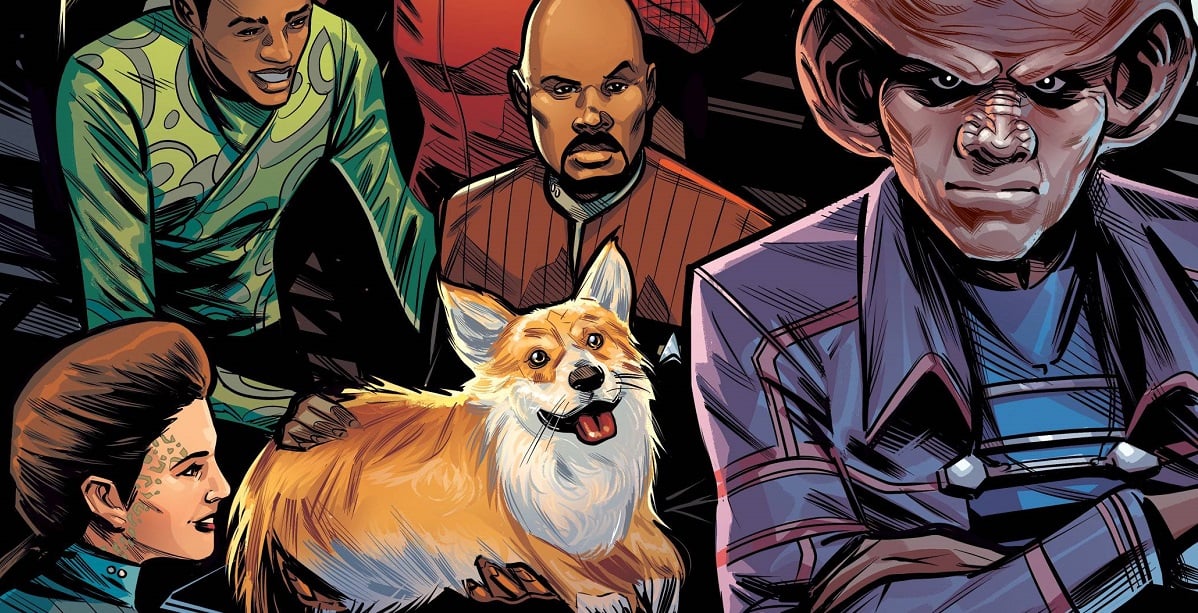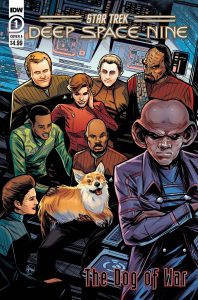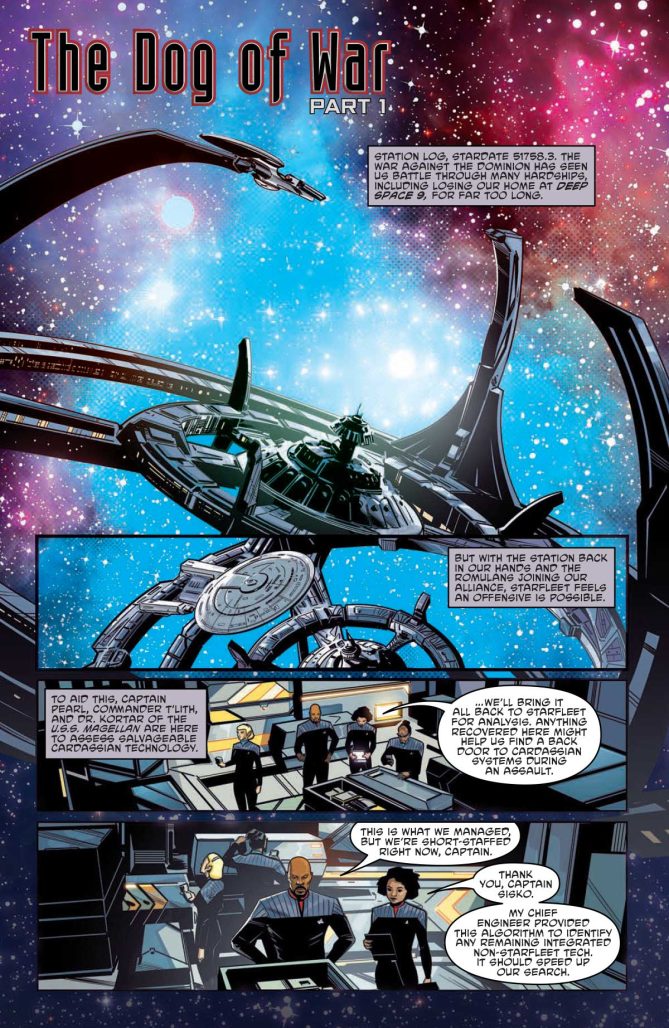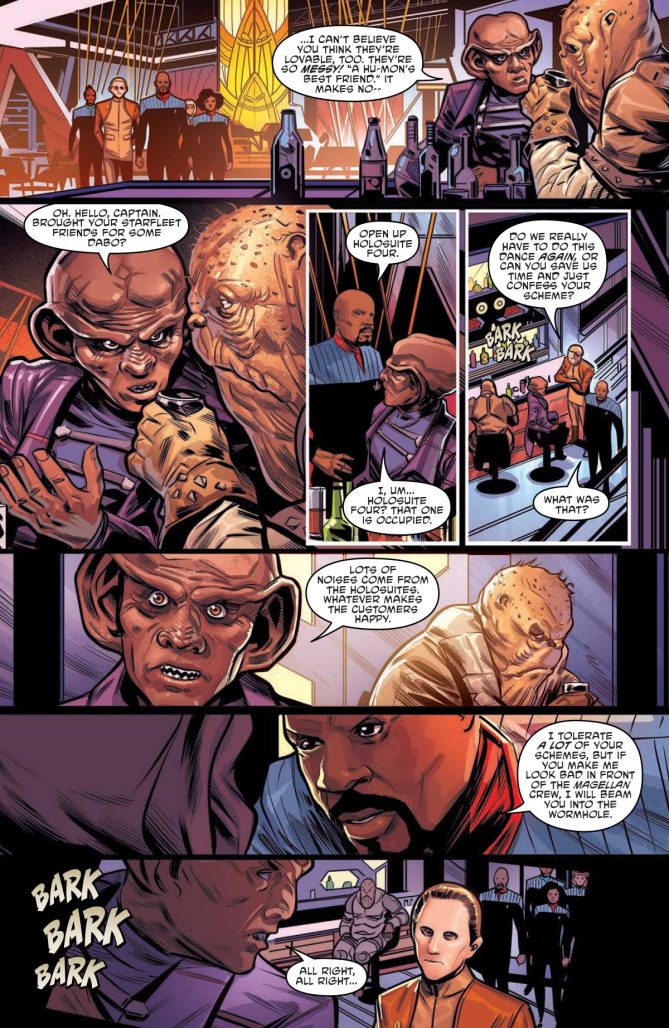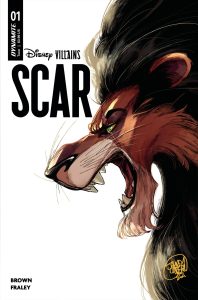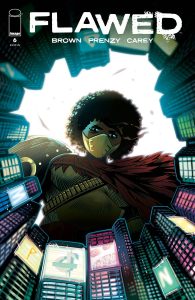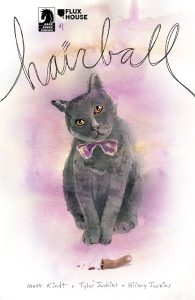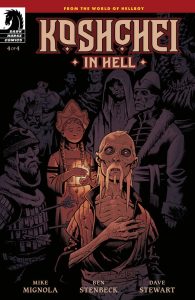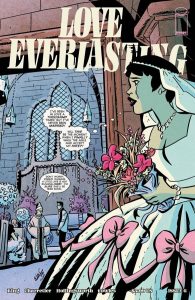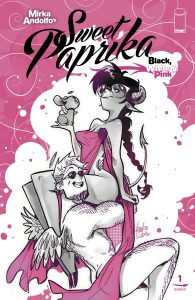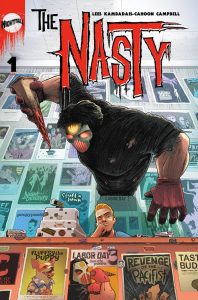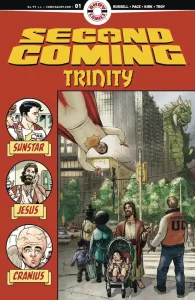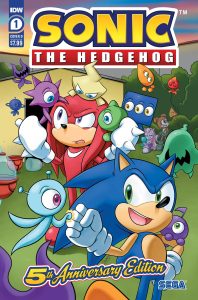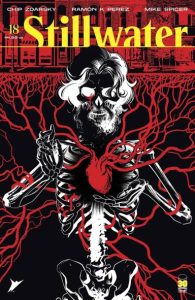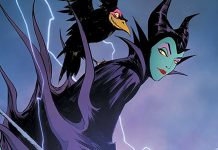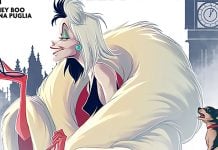This week’s lead review for Wednesday Comics is Star Trek Deep Space Nine – Dog of War #1. Plus, the Wednesday Comics Team has its usual rundown of the new #1s, finales and other notable issues from non-Big 2 publishers, all of which you can find below … enjoy!
 Star Trek Deep Space Nine – Dog of War #1
Star Trek Deep Space Nine – Dog of War #1
Writer: Mike Chen
Artist: Angel Hernandez
Colorist: Nick Filardi
Letterer: Neil Uyetake
Publisher: IDW Publishing
The miniseries Star Trek: Deep Space Nine: The Dog of War has been billed as a “lost episode” of the cult classic among cult classics, Star Trek: Deep Space Nine. The first issue fulfills this promise so thoroughly, you’ll swear you can hear the swell of the show’s orchestral fanfare when you turn a page in Dog of War and begin a new scene.
However, while Dog of War does capture the tone of a DS9 episode, it also takes the story places where the television show was unlikely to be able to go. This includes allowing the canine guest star, an ostensibly purebred corgi, to play a significant role.
There have been several pets throughout the history of Star Trek, including The Next Generation’s Spot the cat and Enterprise’s Porthos the beagle. However, budgetary constraints and the practicalities of having an animal star on set have limited the amount of screen time these furry actors can share with their human counterparts. But just as in the issue of last year’s Star Trek: Discovery: Adventures in the 32nd Century that featured Grudge the cat, The Dog of War capitalizes on the fact that these limitations don’t exist when telling a Star Trek story on the comics page.
With the full potential of the “Quark paired with a corgi” premise unleashed in Dog of War, we get plenty of dog action in this inaugural issue. This includes both scenes at the dog park in Quark’s holodeck (feat. Vic Fontaine) and recognition of the fact that as a Changeling, Odo can adopt the form of a dog (see also: DS9 season 4’s “Little Green Men”). Plus, Quark is a prime figure to highlight both the seedier, capitalistic side of dog breeding, as well as serve as a prime target to be won over by the four-legged visitor’s charms.
This comic goes out of its way to ensure that all of your favorite DS9 characters get a chance to appear, including Morn. Well, almost all of your favorite characters: but there’s still time for more cameos on the coming issues.
Like the three-issue 2022 Star Trek: Lower Decks miniseries, Dog of War is set on a specific Stardate: in this case, 51758.3. This means it takes place during DS9 season 6, during the Dominion War. Having a connected secondary plot that features Sisko contemplating using Borg tech to turn the tides of war emphasizes the fact that the story takes place during this point on DS9’s timeline. While I may personally prefer the (seemingly) lighter-hearted corgi-subplot to this higher-stakes storyline, tying this storyline into one of the most memorable TNG episodes ensures my interest in every element of this issue’s plot remains piqued.
The art throughout Dog of War is excellent, capturing the aesthetics of the space station and its computer screens as well as the look of each individual character, while still offering fresh and unfamiliar action. Furthermore, several panels are squeal-worthy in and of themselves, especially those that take place in the aforementioned holo-dog park. The coloring is excellent throughout, and the lettering clear and easy to read. Plus, my fellow Cali class devotees will want to be sure and check out Chris Fenoglio’s Dog of War variant, which remixes our favorite beta shift into the seminal episode “Take Me Out to the Holosuite.”
Verdict: Head to Quark’s and replicate a copy today.
Wednesday Comics Reviews
Disney Villains – Scar #1 (Dynamite): Dynamite continues to strengthen their new line of Disney-licensed comics by this time taking a walk on the wild side and exploring the bad guys in Disney Villains: Scar #1. Written by Chuck Brown, drawn by Trevor Fraley, colors from Chiara Di Francia, and letters from Jeff Eckleberry, the entire creative team delivers a story full of old and new. Set a short time prior to the events of The Lion King film, Scar dives deep into what drives the king-slayer to regicide, showing a new side not shown in the film, but still familiar enough to not be surprised by his future actions in the off chance this is your introduction to the character and story. Villains always seem to be the most interesting draw for new stories these days, and the launch of this Disney Villains line with Scar at the head of pride is a strong sign for bad (*wink*) things to come with future titles in the Villains line. —Bryan Reheil
Flawed #6 (Image Comics): Flawed #6 is a beautiful, bloody conclusion that feels satisfying in the way writer Chuck Brown wraps up loose ends while still leaving much more to explore in this world. There’s just more story left for Gem here as she walks the line between masked hero and monster. As Higgs has become something terrifying, there’s an interesting juxtaposition between him and Gem, as she engages in similar violence, functioning as an almost direct mirror to him. Artist Prenzy makes fantastic use of the real estate of two page spreads, really letting the carnage have the space to linger and a detail that really works throughout the series is the use of blurs to really push the reader’s focus. It adds a layer to the “camera” and the art and beautiful warm colors that are on full display, letting the lights bleed through the compositions in a way that is deeply visually satisfying. The letters by Becca Carey weave through and around the art, feeling like a natural extension of the work and adding another layer of expressiveness to the characters especially as they are visiting violence upon someone or having violence visited on them. A quote from Nietzsche comes to mind: “He who fights with monsters might take care lest he thereby become a monster. And if you gaze for long into an abyss, the abyss gazes also into you.” Gem is certainly lucky to have a psychiatrist in her aunt but that comes with its own issues when Ammit is in the practice of creating monsters herself. —Khalid Johnson
Hairball #1 (Dark Horse Comics): Trigger warning for domestic abuse (verbal). In this particular Matt Kindt (script) and Tyler Jenkins (art/letters) outing, familial horror is back on the menu. From placing our perspective simultaneously with the unnamed young girl’s therapist and omnisciently following the events at home slink all nefarious-like on the periphery, the dialogue clouds the resultant negative space like a confessional rather than a therapy session. We never know the names of those involved beyond the eldritch horror coughing cat, so our unfamiliarity breeds a dehumanization of these characters into their base forms: adopted girl with abusive parents, a male breadwinner with a verbally abusive tone, and a (yawn) drunk mother. The characters speak with venom and a distinct lack of skirting their intent. It’s rough for readers coming from divorced, adopted, and/or abused households, so please be wary. Jenkins keeps the layouts to a stark formalist manipulation of four quadrants, which coalesces the visual info to get you into the rhythm of abuse signature of these upbringings; it’s honestly wicked work. While I admire the To Catch a Thief scenes where we follow a supernaturally ominous cat in twilight blue, Hilary Jenkins (colors) plays the subjective scenes warmer than cool, which comes off inconsistent with the tone, but since it’s a toothy watercolor texturing scene, it balances out perfectly. If you can stomach a well-structured tale of sad bad dads and the households they build, give this one a look. Personally, I’m hitting the exit corridor before it gets darker– y’know, curiosity killed the cat and all that. —Beau Q.
Koshchei in Hell #4 (Dark Horse Comics): This issue was a fantastic read for long-time readers of Hellboy, paying off a number of storylines that had been building for years across other titles in the Universe. Koshchei is also one of the more interesting characters in Hellboy, and his arc gets some nice resolution (as much as it can) in this one. Written by Mike Mignola, this series also features art by what might be my favorite duo regularly working on Hellboy comics at the moment, with artist Ben Stenbeck and colorist Dave Stewart. It was also lettered by Clem Robins, the unsung hero of Hellboy comics production. This miniseries is a must-read for those following the wider Hellboy continuity. —Zack Quaintance
Love Everlasting #6 (Image Comics): What a treat this series has been from the start, with each issue standing relatively well on its own while also laying down some connections, repeated structures, and throughlines. With this issue starting its second arc, the creative team here wisely decides to subvert expectations of what is going to happen — both for readers and for our protagonist. It’s a great choice that elevates an already strong series even higher. What’s resulting from all of this is nice trip through individual stories as well as through the history of comics trends and conventions and tropes. This issue was written by Tom King, illustrated by Elsa Charretier, colored by Matt Hollingsworth, and lettered by Clayton Cowles. —Zack Quaintance
Mirka Andolfo’s Sweet Paprika – Black, White, and Pink #1 (Image Comics): Hot on the tails of the comic zeitgeist, Mirka Andolfo is back with an anthology set to the tune of black, white, and a spot color (pink), and while refreshing to see a non-Big Two creator tackle this medium, it doesn’t explore as much as one would hope. Featuring a slew of artist knockouts like Retsu Tateo of Full Metal Panic fame, Stjepan Šejić, Otto Schmidt, Emilio Pilliu, Xong Bros, Elisa Ferrari, and Gabriele Bagnoli, few decided to make thematic use of the pink spot color outside of Pilliu! Pilliu, paired here with writer Steve Orlando, sticks with the established uses of an anthology spot color: title text, hearts, background effects, and a character color. But where Pilliu stretches the creativity is in using the pink to separate visions from reality in our daydreaming queer’s work day; not to mention a non-diegetic reveal that can only work with this specific anthol gimmick cuing readers into itself. I feel there were some crossed wires for the two Anisette shorts where one poorly paints a moment of validation during a train accident and the other illustrates Anisette as a wretch falling forwards into a dom/sub kink with a colleague (as one does in the world of Sweet Paprika, mind you). Aside from editorializing some of the results, Black, White, & Pink ends up exactly as ya want: hilariously horny, somewhat reprehensible, gorgeously penned, and lightly sprinkled with romantic comedy. Come get some! —Beau Q.
The Nasty #1 (Vault Comics): Vault launches a new coming-of-age ode to horror films and fandom with The Nasty, written by John Lees, with art by George Kambadais and Adam Cahoon, and letters by Jim Campbell. In this first issue we are introduced to the main character, Thumper Connell and his imaginary friend — the massive slasher monster from a favorite horror movie of his childhood. Lees’ script is endearing and earnest with a clear love and nostalgia for the horror films and VHS Rental stores of his youth. While the fantasy elements are only hinted at in this first issue, the characters and their small town world feel alive and the fantastical elements’ slow introduction threaten to tear it all down in the best way. The art by Kambadais is frankly not the artist’s best work, with pages uneven in quality and detail, but when it works, the characters are joyfully cartoony and expressive. It’s a strong start for a series that should help fill the void for anyone tortured by the gaps between seasons of Stranger Things. —Tim Rooney
Second Coming – Trinity #1 (AHOY Comics): This week marks the return of the best satire in comics. Second Coming’s premise involves Jesus rooming with a Superman analog. But the Superman analog in this comic isn’t exactly a paragon of virtue. He’s far more complicated and realistic than all that. As such, he has a rogues gallery, one of whom has been in his life for many years. And this issue basically serves up that person’s side of the story — and it’s as compelling as it is heartbreaking. The result is an exceedingly well-done issue that fits well into everything we’ve gotten from Second Coming in the past, and is also satisfying on its own. This issue was written by Mark Russell, with layouts by Richard Pace, finishes by Leonard Kirk, colors by Andy Troy, and letters by Rob Steen. —Zack Quaintance
Sonic The Hedgehog #1 – Fifth Anniversary Edition (IDW Publishing): The Sonic the Hedgehog #1: Fifth Anniversary Edition hits shelves to celebrate the Blue Blur’s fifth birthday of comics published by IDW. Reprinting the first issue for new readers with the creative team of writer Ian Flynn, artist Tracey Yardley, inks from Jim Amash & Bob Smith, colors by Matt Herms, and letters from Cory Breen. Included in the issue after the reprint is an all-new story in the world of Sonic that builds off an adventure had in this very first issue. That story sees the creative team add Shawn Lee aboard to handle letters. To close out is a cover gallery collecting full-page images of all the Issue #1 covers from back in 2018. If you missed out on picking up a copy of #1 back then, now is as good a chance to get on it and hopefully liking it enough to continue on with Sonic’s wild adventures thanks to the handy reading guide at the end of the issue! —Bryan Reheil
Stillwater #18 (Image Comics): I thought the first two arcs of Stillwater were among the strongest of any original comic idea in a good while. It was a strong concept, played out well with compelling intrapersonal drama. That’s all to say that the third arc ended up losing me a bit. This week gives us a final, over-sized issue, and while the storytelling is fine and the art very strong, I felt a little unsatisfied by this one. Looking back over the past 18 issues, the trajectory feels a bit unbalanced, as if the characters and elements needed to realize the end game were added sort of hastily, too close to the latter half of the series, rather than developing more patiently throughout. That said, I’d like to give this entire series a revisit at some point; I’d be happy to find that it reads very well all together. This finale was written by Chip Zdarsky with art by Ramon K. Perez, colors by Mike Spicer, and letters by Rus Wooton. —Zack Quaintance
Read more entries in the Wednesday Comics reviews series!
Wednesday Comics is edited by Zack Quaintance.



